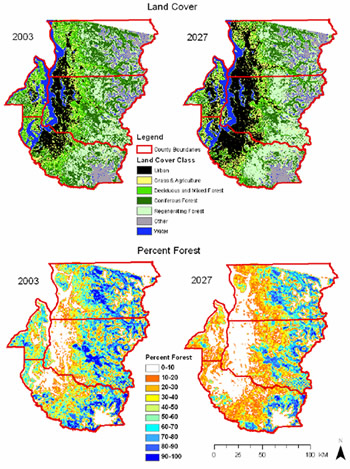Investigators: John Marzluff, Marina Alberti, and Jeff Hepinstall
Project Description
We have two efforts exploring the interactions between people, urbanization, and birds in the Puget Sound region. The first builds on our work from our previous Biocomplexity award by linking spatially explicit models of expected land cover change with changes in bird diversity and abundance. We have produced two papers on this topic in 2007 (Hepinstall et al. 2007a,b). Our models project a decline in total species richness for the four county region from a mean of 34 or 36 in 2003 to 30 or 31 in 2027, respectively (Figures 1,2). Maps generated from projecting the full and the simple models show that changes in species richness are expected to be concentrated in those regions of the study area where land cover change is most dramatic (Figure 2). This is primarily in the transition development zone surrounding the present heavy urban core where forest loss and aging of developments cause the greatest changes in land cover (Figure 2). Urban and transitions zones are expected to decline in total species richness from 33 to 24 and 37 to 31, respectively (Figure 2). Additional publications on this work are forthcoming.
The second area of urban avian research is the coupled cultural evolution of people and crows. We have produced a review paper of this topic that investigates the evolutionary (genetic and cultural) responses of animals to people in urban areas (Marzluff 2007) and have documented long-term memory of specific people by crows. We have proposed to expand this work to look at coupled human and crow attitudes with Dr. David Craig (Willamette University), who has submitted a Research Opportunity Award proposal to the Biocomplexity program chair.
Read more:
Projects: Biocomplexity I; Biocomplexity II
Publications:
Hepinstall, J.A., J.M. Marzluff, M. Alberti. 2007. Predicting avian community responses to increasing urbanization. Studies in Avian Biology. In Press.
Hepinstall, J.A., J.M. Marzluff, M. Alberti. 2007. Modeling the responses of birds to predicted changes in land cover in an urbanizing region. In J.J. Millspaugh and F.R. Thompson III, eds. Models for Planning Wildlife Conservation in Large Landscapes. Elsevier Science. In Press.
Marzluff, J.M. 2007. Urban evolutionary ecology. Studies in Avian Biology. In press.
